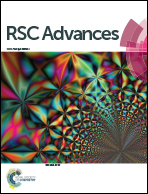Synthesis and insight into the structure–activity relationships of 2-phenylbenzimidazoles as prospective anticancer agents†
Abstract
In order to explore and develop new anticancer agents, three series of 2-phenylbenzimidazoles, 15–46, were condensed under simple and mild conditions using sodium metabisulfite as an oxidation agent and another series, 47–55, were obtained via a reduction reaction using sodium borohydride. All the compounds synthesized were evaluated for their in vitro anticancer activities against three human cancer cell lines. The novel compound 38 was found to be the most potent multi cancer inhibitor against A549, MDA-MB-231, and PC3 cell lines (IC50 values 4.47, 4.68 and 5.50 μg mL−1, respectively). In addition, compound 40 exhibited the best IC50 value of 3.55 μg mL−1 against the MDA-MB-231 cell line. The results demonstrated that introducing a new substituent to compounds 37–55 could improve their antiproliferative activities.



 Please wait while we load your content...
Please wait while we load your content...